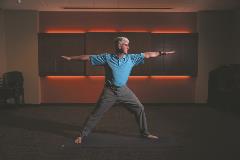On September 23, we will experience the fall equinox, which is one of two points in Earth’s orbit where the sun creates equal periods of daytime and nighttime across the globe. Day and night will be in balance. I, like all of us (let’s be honest), struggle with finding balance in the legal profession. I do not mean just work-life balance; I mean, where I fit in the legal profession and whether joining the legal profession was a good choice for me. For me, yoga helped me find balance, but it certainly wasn’t always this way.
I attended my first yoga class in 2009. A co-worker challenged me to join her for a noon yoga class at the Hennepin County Government Center. The class ended like every other yoga class, in corpse pose. The Sanskrit term is “Savasana.” All you do is lie still on your back, with your palms facing up in a receiving fashion. “Here I am, Universe, take your best shot!” It made no sense to me. I asked the teacher, “Why don’t you just end class five minutes early so we can get on with our day?” I stuck with regular yoga classes, but thought yoga was what I could do when I was too tired to do a real workout. I thought the benefits were the stretches and the exertion of attempting awkward shapes. It took several years of practice to realize that yoga has nothing to do with the poses.
In early 2014, my career was not going according to plan. On the first Monday in February, I attended a noon yoga class and purposely chose a corner of the room. The teacher said: “The Seattle Seahawks won the Super Bowl yesterday, and I read that they meditate, so let’s begin class in seated meditation.” The teacher had us shut our eyes and notice our breath. After five minutes, the teacher remarked, “If you continued to meditate for the whole class you would receive the same benefits as if you did the yoga poses. Or, if you are ready to move, I will guide you.” Since no other stress-relievers in my life were working for me, I figured I would keep meditating. I lasted for another 10 minutes or so. At the end of the class, I approached the teacher and asked her what would be the benefits of meditating for an hour. Her eyes got wide, and she told me I would be more responsive and less reactive. I would be calmer. I would be less apt to interrupt, or to judge, or to criticize. I thought to myself, “I could use more of that in my life.” That is how I learned that yoga is a moving meditation. All you have to do is breathe, and add some movement. For example: Breathe in, arms to the sky, look at your hands. Breathe out, bend to the right. Breathe in, bring yourself back to the center and stretch a bit taller. Breathe out, bend to the left.
I kept attending the Monday yoga class. I felt calmer after the classes. I also started listening to the teacher. In one class, she said, “Face the mirror, and try not to compare your version of the pose with the person next to you.” She then added, “And when you leave the yoga studio, try not to compare yourself to others.” That touched a nerve. Whether in the context of law school, or seeking a job after graduation, or practicing in my own field, I had spent over 20 years in the legal profession comparing myself to others.
Other bits of wisdom I learned in the middle
of a yoga class:
• Focus on the action, let go of the outcome. Focus on completing the current pose, and let go of what it looks like. What if during my next CLE presentation, I focused on the presentation and let go of my attachment to the outcome?
• The transition between two yoga poses is another yoga pose. What does the transition look like between me reading an email and firing off a response? Or, stopping what I am working on to pick up the ringing phone? Or, lurching from one meeting to the next? Am I focused on the task at hand, or have I mentally moved on to the next task (e.g., the next yoga pose)?
Yoga is not a workout. Yoga is a work-in. It is a finite period of time where you can pay attention to yourself, and practice self-observation without judgment or criticism. You do not have to leave your problems at the door and enter some “Zen space.” You can bring your problems in with you, and they will seem more manageable after that final Savasana (which I now realize is the most important part of class). It is a practice. You get do-overs. You do not have to be perfect at it.
And therein lies the balance.

matthew@matthewfoli.com
Mr. Foli is a real estate attorney/yoga teacher. He works at Guaranty Commercial Title, Inc., as a title examiner, and teaches yoga every week. He co-leads the HCBA yoga club.